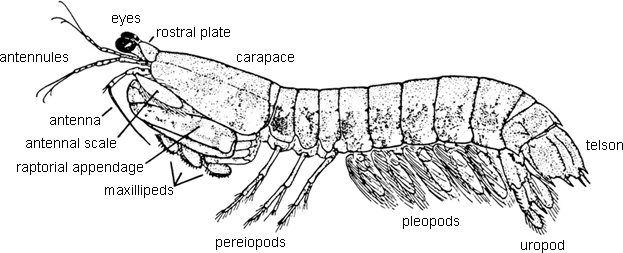
External Anatomy and Explanatory Notes
External anatomy of a typical stomatopod

Regarding other species not on the list
Several other large spearers are available live in fish markets around the world. These include, but are not limited to, Lysiosquilla scrabacauda from the western Atlantic, Lysiosquillina sulcata in French Polynesia, Harpiosquilla harpax in Thailand and Hong Kong, Oratosquilla oratoria (shako) in Japan and Hawaii, and Squilla mantis in the northern Mediterranean. I have not included them here because they are often found on ice and rarely survive in the home aquarium. However, if you can find someone who works on a trawler, they will sometimes save live specimens for you.
Regarding the species descriptions
Species: Scientific name
Common name: In English; when possible, I have tried to provide common names used in the aquarium trade
Functional type: Spearer or smasher after Caldwell & Dingle, Scientific American, 1976
Range: General locations where the species is found
Habitat: General habitat such as reef flat, sand flat, coral reef, coral rubble
Depth: Depths at which captures have been reported; this will give you some idea as to the type of lighting required; only species occurring above 5 m tolerate full intensity lighting
Home: Type of cavity or burrow used
Diet: Where known, items found in the stomach or observed in the burrow or cavity
Size: Post-larvae to largest recorded adult; this is total length from tip of eyes to tip of telson
Color: Hopefully, the color images will be of more help
Distinguishing Characters: The characters I used to quickly identify animals; if you know the location that the animal is from, you should be able to identify the stomatopod from this information
Activity: When the animal hunts or leaves its cavity or burrow; some primarily day active animals will become active during the night when there is a full moon
- Aquarium Requirements: Assuming that you have a well-cycled tank...
Temperature: Based on specific habitat and my success keeping these animals
Salinity: Based on specific habitat and my success keeping these animals
Cohabitants: Based on typical prey and my experience; obviously you should not keep valuable fish or other delicate animals with any stomatopod
Aquarium size (adult): Based on a large adult; this is the minimum total volume
Aquarium substrate: If the animal requires some type of cavity (as all stomatopods do), I have indicated this by including “cavity”; this could be pvc or a natural cavity
Suitability for Aquarium: Basically reflects my success keeping these animals
Availability: From general experience with what arrives in the United States or that is available from U.S. collectors; I do not promote specific suppliers (so please don’t ask!)
Back to the Species Directory